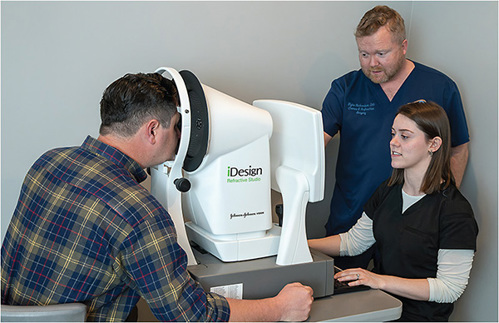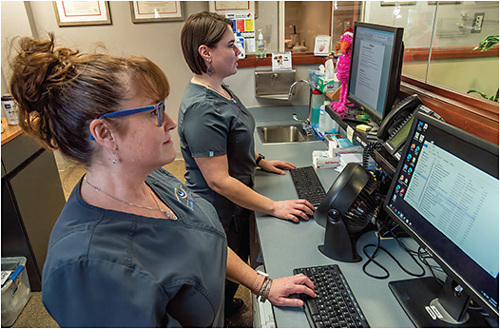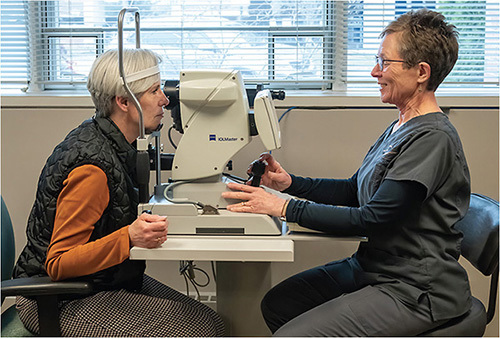PHOTOGRAPHY BY BRUCE PRESTON PHOTOGRAPHY

With so many subspecialties in eye care, it’s not uncommon for patients with multiple ocular comorbidities to see several doctors. When Concord Eye Center brought these multiple specialties under one roof, it not only did a great service for patients but also expanded the horizons of ophthalmic technicians and staff who now have many paths for growth.
Of course, training can be a challenge for any practice — but a large multi-specialty practice that spans two major locations is a whole different ballgame. That includes a hospital campus that is part of Concord Hospital. Fortunately, the New Hampshire-based practice has found ways to make training successful.
Spurred by growth
In total, the practice has approximately 150 employees with nine owners/partners that includes approximately 45 technicians between their two locations. Specialties include cataract, cornea, retina, glaucoma, oculoplastic, pediatrics, and general ophthalmology. General practice ophthalmologists may see as many as 50 patients in a day — and each doctor is generally assisted by three technicians.
“We typically have the techs work up patients in individual exam rooms, then the doctor and their scribe move between the five exam rooms in their pod,” explains Patricia Bourgault, vice president of operations. “In the past, we did not have scribes — the doctors would handle seeing patients with the assistance of one technician — but since moving onto the Concord Hospital campus, we’ve experienced huge growth in the volume of patients and have needed to delegate more tasks.”
Training is typically performed in-house by staff trainers, explains Candice d’Hemecourt, COA, clinic manager. Lead technicians generally take on most of the training responsibility. However, at the height of the pandemic, some increased turnover necessitated hiring an influx of less-experienced people. That lead the practice to bring in Jane T. Shuman, MSM, COT, COE, OCS, president of Eyetechs and co-editor of Ophthalmic Professional, to get a group of new hires up to the point where they could be on the floor, at which point staff would continue their training.
“Having an outside resource does remove a lot of the burden from us, at least in terms of getting a new hire up to speed,” says Ms. d’Hemecourt. “Then, we can keep things moving forward.”
Education is critical
Ms. Bourgault adds that, in recent years, it has been increasingly necessary to hire technicians without previous ophthalmology experience — as eyecare-experienced candidates “just aren’t out there.” But with a focus on education, the practice has been able to ensure these individuals get the training they need. (For more on training those without a background in eye care, see “Set up a ‘Tech Training 101.’”)
“As soon as a tech comes to us, we encourage them to start studying to become a Certified Ophthalmic Assistant [COA]— something that they can achieve in 6 months to a year with on-the-job training,” she continues. “We purchase their books and pay for their exam, and we want techs to know they have our full support to become certified. We then display their certificates in the clinic and acknowledge their accomplishment with a compensation review.”
Ms. Bourgault says that “on-the-job training” has allowed the practice to continually move forward while also ensuring staff has opportunities for advancement. This is something that Laura Flynn, COA, says has benefited her.
“I started out as a medical assistant,” she recalls. “Because they do on-the-job training and because my mentors were so great, I felt I learned a lot. They really value teaching.”
The value of cross training
With such a large, multi-specialty practice, a need for cross training has been inevitable. That has been true across specialties, but also across various roles.
“Some of my more qualified technicians originally came from our call center or the front desk,” says Ms. Bourgault. “In the 30 years that I have been here, I can tell you that not having an ophthalmology background is not nearly as important as not having the right personality for the job. If you aren’t compassionate or caring, then health care is probably not the right field — you can’t train someone to become those things.”
Sean Conaway, COA, a former technician and now the director of refractive services and surgical coordinating, is one of those individuals who has benefited from the career opportunities available in such a large practice. He says that the skills learned in one role can easily bring value to another role.

“My background in the clinical as a technician combined with my experience at the ASC have directly translated into leading our refractive and surgical departments,” Mr. Conaway says.
He believes that Concord Eye’s growth has created new opportunities for many of the staff that otherwise might not be available in a smaller practice. “I think it makes us unique that we continue to grow by adding new physicians and crossing into new subspecialties. There’s no question this has also benefited patients tremendously. It’s a wonderful thing to be able to keep patients here, in-house, and not have to send them outside of the practice where we aren’t really as in touch anymore with their care,” Mr. Conaway says. “Our doctors all interface with one another for the best possible, streamlined care for the patient.”


Floating when needed
Across specialties, techs are generally set up with their “homebase,” where they mostly work with the same doctor (or maybe a couple of doctors). However, because of cross training, they are able to “float,” when needed.
But, this brings the challenge of learning each doctor’s preferences. Erin Fogel, MD, a corneal specialist and partner of the practice, says that the doctors do adopt much of the responsibility for ensuring techs learn these differences.
“It’s really on us to train techs on our individual preferences and anything that we might prefer as far as patient work-up and flow,” explains Dr. Fogel. “Techs are already well-trained in the practice in general when they come to us, but it’s on us as doctors to spend time with them on anything personal to us. As a practice we recognize that the work you put into training directly affects what you get out of it — and you can’t expect anything different. You have to invest the time.”
For added help, the practice also maintains updated access to protocols in a shared folder that all staff can access, says Ms. d’Hemecourt. “If a tech ends up with a doctor who they haven’t been with in a while, they can check that folder for reminders,” she explains.
This is something that Ms. Flynn says she has appreciated. “It’s a lot of fun to work with so many different doctors all in one practice, but it can be difficult to remember what every doctor wants when you bounce around,” she says. “I love that we can just look up their preferences in the provided clinic protocol guide — and the doctors really appreciate this, too. This is a great integrated source to ensure we have all necessary testing and information.”

One big family
For such a large practice, the doctor-staff relationships are strong. In fact, Ms. d’Hemecourt calls Concord Eye a “big family.”
“I think it’s fairly unusual to have such a large practice in which so many of the doctors and staff have been here so long,” she says. “But it comes down to the fact that doctors really care about their staff and invest their own time in training them. They want things a certain way, but they take accountability for that. This makes the doctor and the technician feel on the same team.”
Dr. Fogel says part of that is helping technicians to understand the “why” behind the work they do.
“If they’re using an instrument or performing a test, they want to understand why they’re doing it — and that leads to much more buy-in,” she says. “With so many patients, we do often have to perform the same task over and over again, so it’s important to have an understanding of why that matters.”
Anytime there is an opportunity to teach technicians a new skill or technique — or show them a new instrument — it's an opportunity to avoid stagnancy.
“Nobody wants to feel stagnant,” Dr. Fogel says. “Techs want to learn new things — it keeps their jobs more interesting.”
Mr. Conaway adds that these are some of the reasons why Concord Eye has such well-rounded staff.
CONCORD EYE CENTER
- Founded: 2014 (merge date); individual practices started in the 1970s
- Doctors: 12 MDs, 2 ODs
- Allied Health Staff:
- - Business office staff including front desk: 20
- - Surgery coordinators:8
- - Scribes: 10
- - Technicians: 45
- - Managers: 8
“I think one of the things that we do best here is create opportunities for staff to learn new things,” he says. “A well-rounded team member brings a lot of value to both the practice and the patient’s experience.” OP








